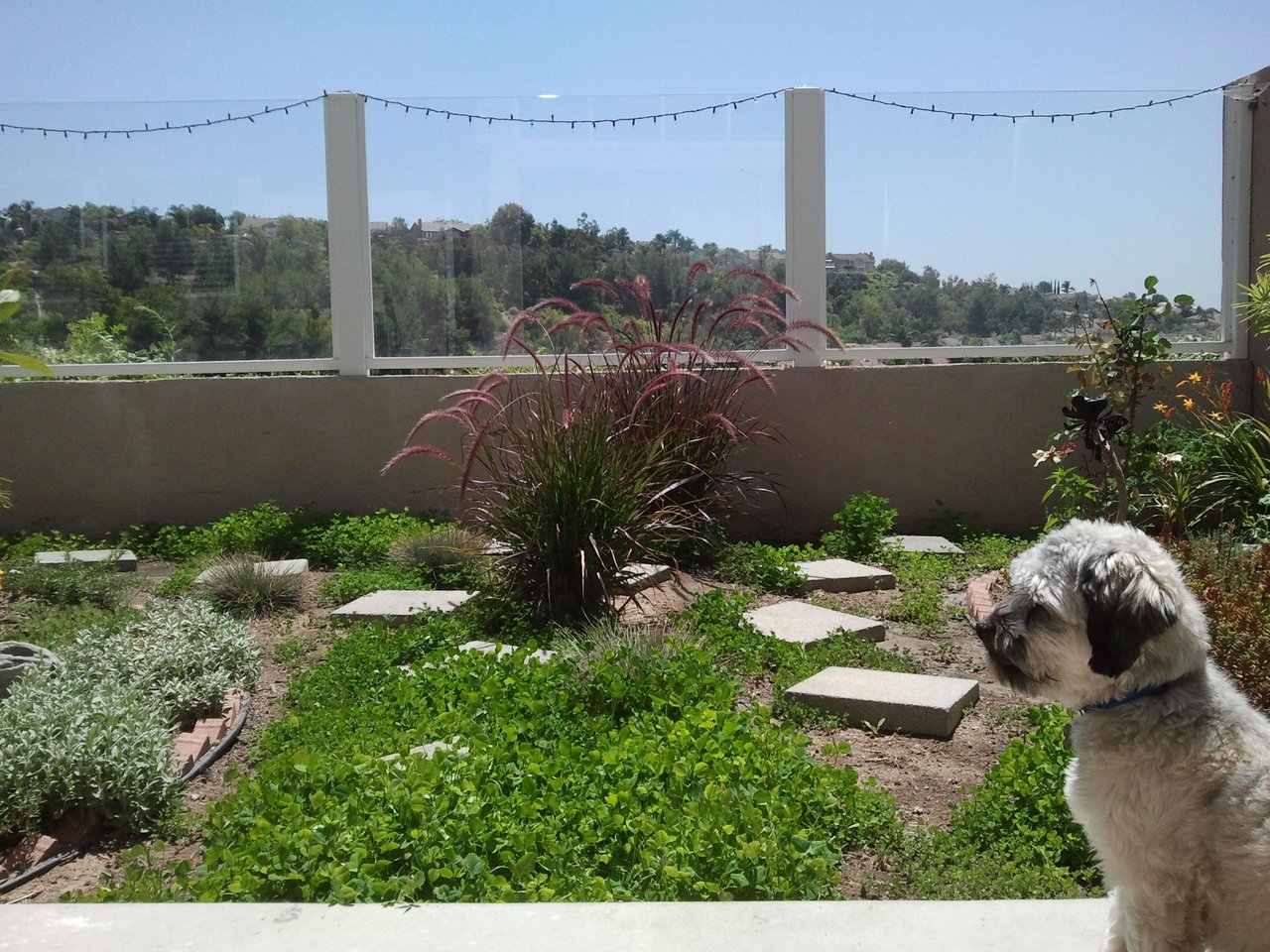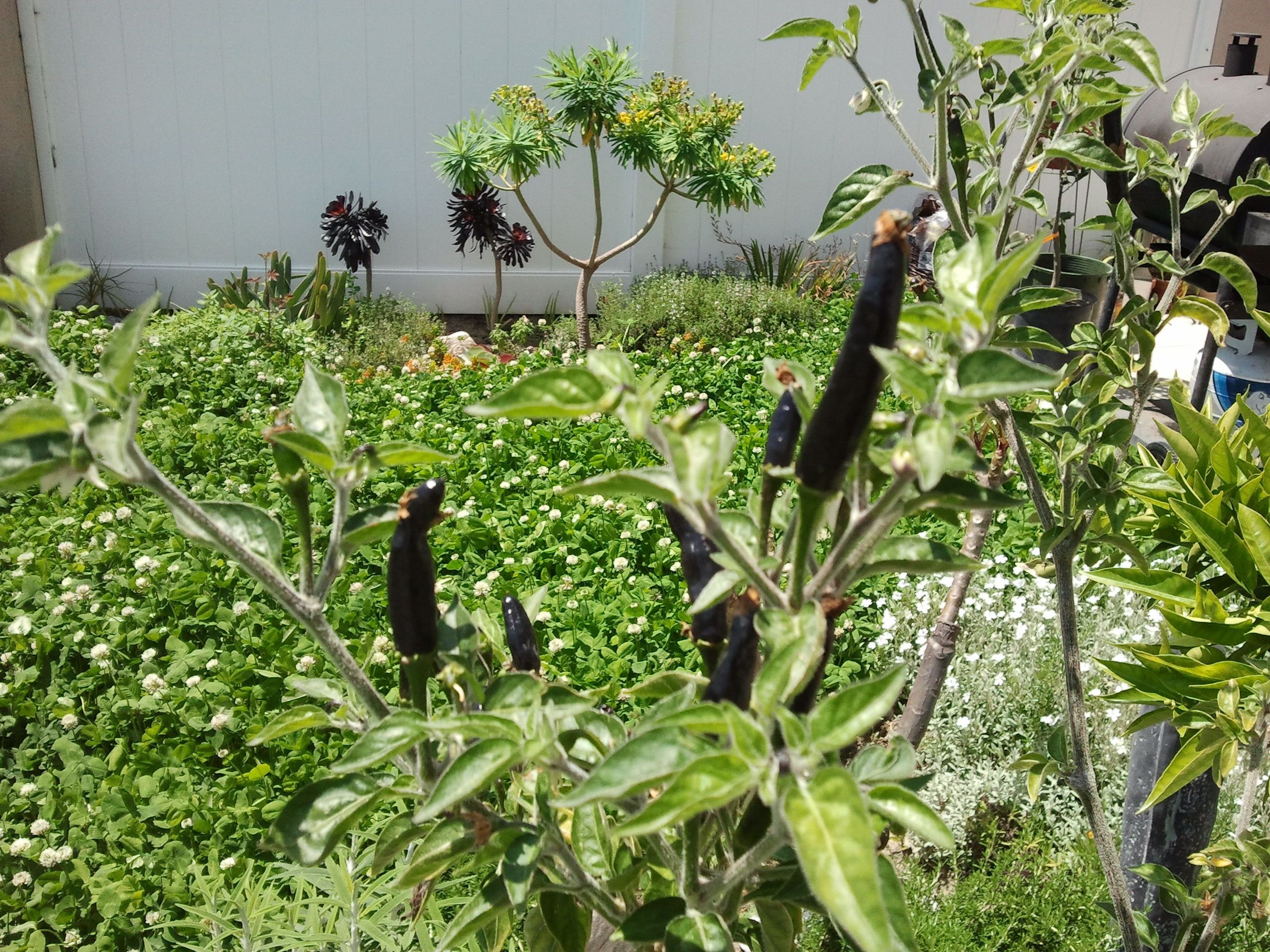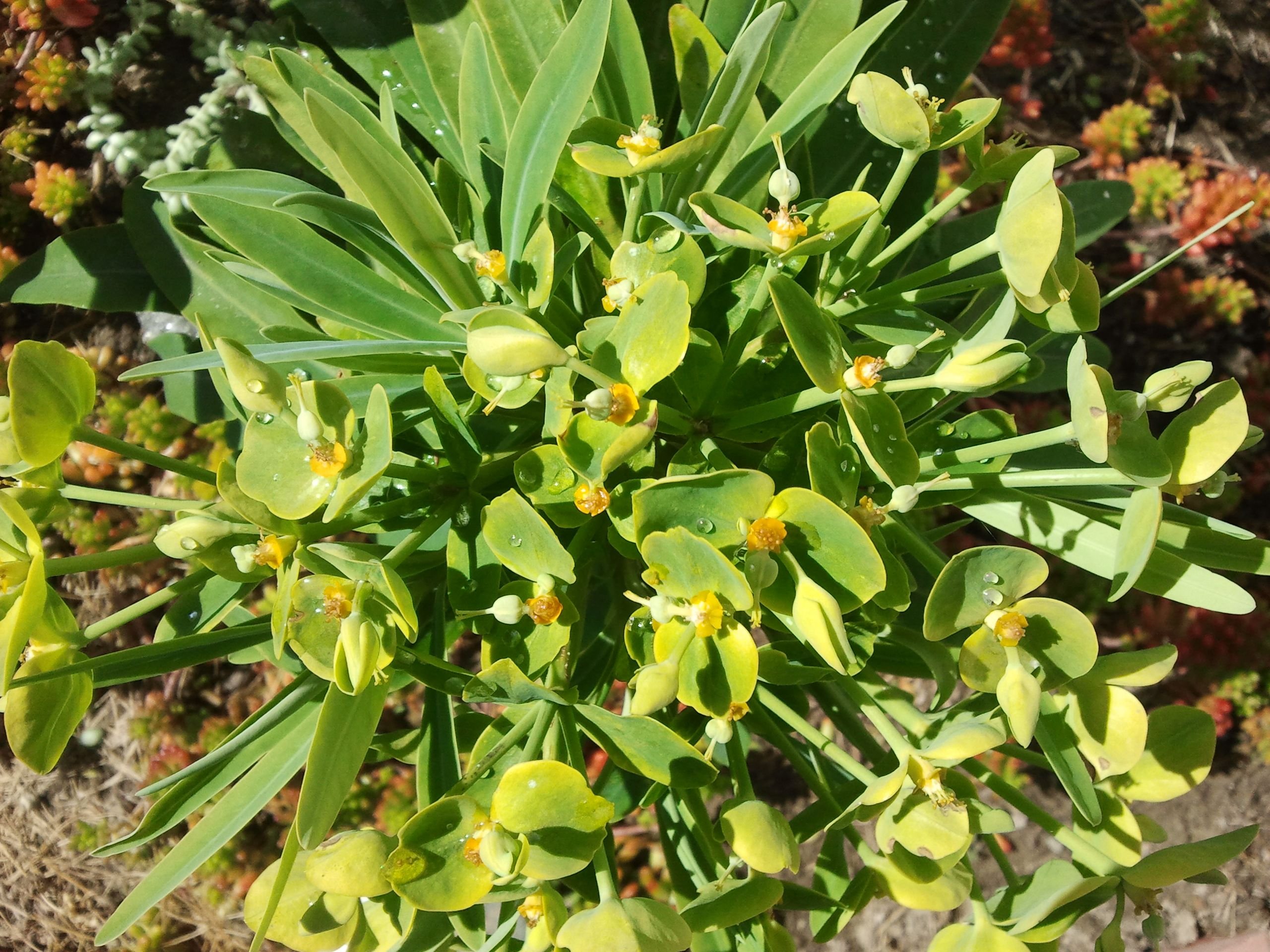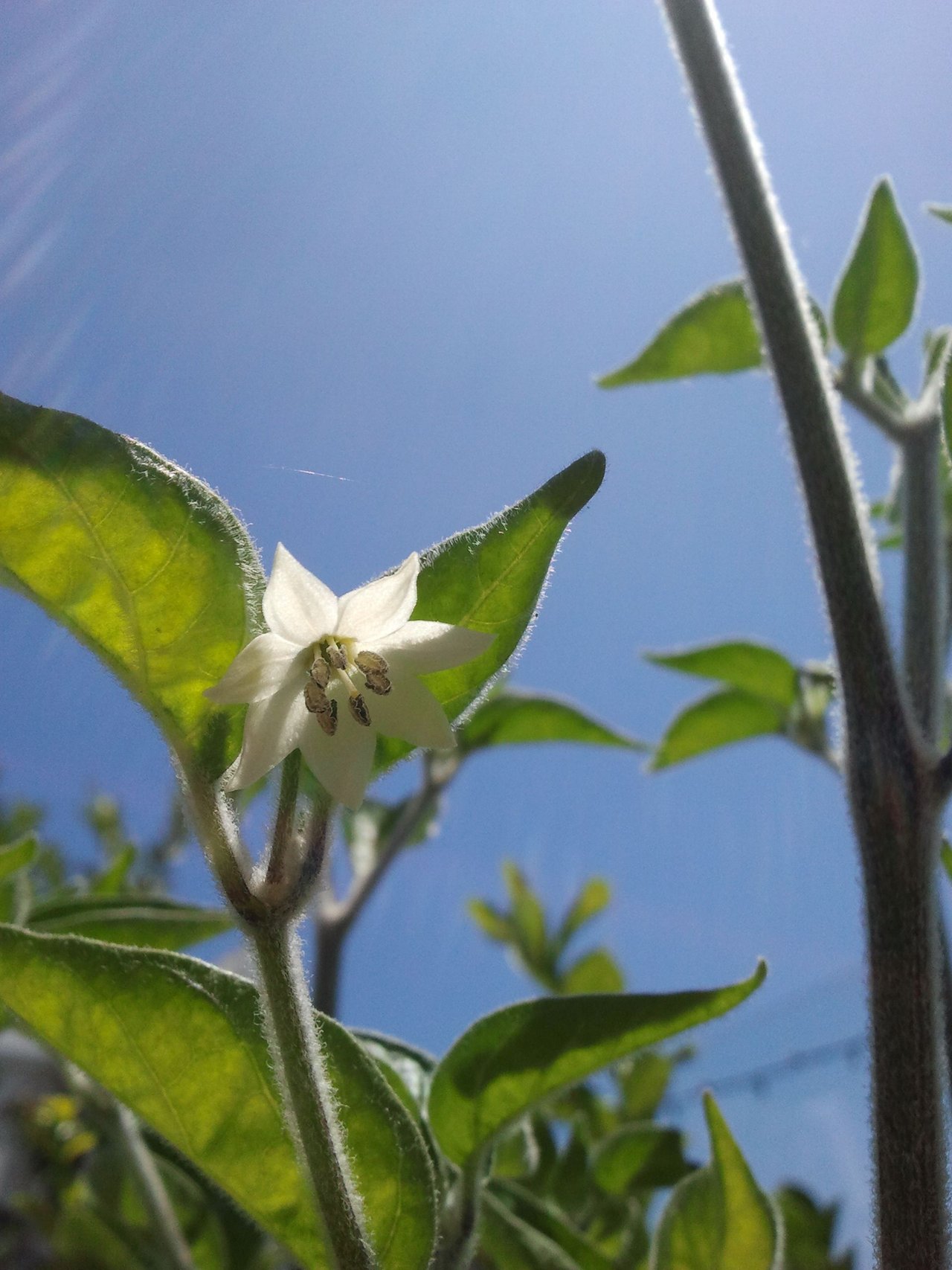I had so much fun putting together photos from this garden! It is helping me remember all the joy I got out of my little < 300 sq ft suburban condominium garden. It's helping me to look back and see how far I came and also remember some of those nuanced lessons that I learned through experimentation.
I couldn't wait to update you all part 2 of this garden tour!
Here is Part 1 of this Suburban Garden Tour in case you haven't seen it yet.
Well I became frustrated that my grass wanted to drink so much water, even for how little of it I was growing. Southern California was experiencing a drought and I wanted to push the grass to see how little I could water it still thrive. I learned that less frequent, deeper watering and cutting the grass to a longer height would help with this. So I did all that. Despite those changes the grass was still thirsty and I couldn't bring myself to put all the water in that the grass demanded.
In retrospect: Although I did add some over the counter fertilizer, I do think that lack of soil fertility and organic matter did contribute to the lack of the grass's robustness. However, mostly it was due to the grass' thirst.
My garden was an oven.
- It had full southern exposure.
- It had two plastic white fences on either side of it which reflected light back into the garden.
- My condo's 2 story walls and windows absorbed heat and reflected it back into the garden.
- The small concrete patio absorbed and reflected heat.
- A small ~1 1/2 ft retaining wall on the south side of the garden absorbed heat
- The plexiglass windows above the retaining wall magnified sunlight shining into my garden
- Walls on all four sides of the garden reduced the ability for air flow
In a much larger yard these factors would not have so much impact but in this tiny garden it all attributed to a HOT garden!! No wonder my grass was so thirsty!!
At 7 or 8 in the morning from late spring to early fall I would go out in my garden to give it water for the day and immediately start sweating. It was often at least 10 degrees hotter than surrounding hillside that didn't have solar heat sinks and reflective surfaces around it.
On the north side of the condo it still had morning shade and was still cool in the morning. However it had black asphalt and by mid day it was also baking, but that's another story :P
I started liking the idea of drought tolerant plants. It didn't take me long to find out about white clover. I found out that a can of white clover seed cost a few bucks at my local garden center.
I immediately bought the white clover seed and ripped out my lawn!
I seeded white clover in it's place, watered it in with a little compost and I had a LUSH white clover patch. In warm conditions it only took 10-14 days to germinate and filled in within a few weeks.

Since the garden was so small and my design included curved edges I wasn't convinced buying a lawn mower was worth the investment. Instead I had purchased an electric string trimmer for "mowing" the lawn and then edging it with the string trimmer and a pair of grass scissors that was given to me.
This lawn maintenance was getting old and the clovers had the added benefit that they didn't need to be mowed if I didn't mind them being 4-5 inches tall. Awesome!
Looking back I was onto a lot more than just less maintenance/labor and less water.
White clovers are an amazing plant:
- Requires less water than grass
- Harnesses nitrogen out of the atmosphere and deliver it into the soil reducing the need for fertilizer (nitrogen fixer)
- Draws in bees
- Eventually grows long deep roots (ask me how I know) and pull minerals from below into their leaves and also helps them require less water with deeper roots
- Leaves can be mowed or cut to add to compost, mulching garden beds or fed to some animals
As you can see from the photo above I was also dabbling in other drought tolerant plants
like this purple fountain grass from the local box store. That purple fountain grass as it turned out was a tad more drought tolerant than I realized. I was so excited to see that it quickly flourished with little water. Then one day I was walking my dog and happened to see a few full grown purple fountain grasses growing and
They were massive!!
And I also observed that the landscapers would hack them back to an ugly stump every year. I though... oh crap that purple fountain grass would fill up so much space in my tiny yard! Beautiful plant, but wrong placement. I was starting to learn that I need to have some idea of how big a plant/tree would get when it is fully mature. Thus helping me know if it makes sense for the space and where it would go so it doesn't overshadow/compete with other plants, aesthetic balance or functional space. And anyway I didn't want to hack this clump of grass back every year, I like a more natural approach to my garden.
So I ripped it out!
And into the compost it went. Now that I think about it it would have made some really nice mulch too.

If you look carefully behind this giant pepper plant you can see my lush white clover patch in full bloom! I was quite proud of it.
After recently working for some farms that raised rabbits and learning that they love white clover
I decided I would go back in time tell my past self-- hey! why don't you raise some rabbits for livestock in your condominium. They are quiet and your neighbors wouldnt even know they were there. The rabbits would absolutely LOVE the white clover forage and you can keep cutting it and feeding it to them... year round in this climate. And they'd give you lovely manure to solve your soil fertility problem. You'd get to learn about livestock and butchering animals that are small and manageable (suitable for a beginner) and get some quality meat out of it!
Here are some rabbits eating clover at a farm in Washington I volunteered with last year. Aren't they cute! Maybe I'll make a post about rabbits on the homestead later if there's interest.
I was also planting trees
I wanted to squeeze several trees in my tiny garden and from the very first design trees were part of it. Actually I ended up planting more trees that I originally planned for: 1 lime, 1 orange, 1 kumquat and 1 plumeria.
As time went on and I learned the problems of heat in this little garden I realized that the trees would eventually play their part and help cast shade into the garden and onto the house and help to create microclimates.
As it were the trees were small and struggling to establish in the heat and with dense clay soil.
Actually funny enough, the kumquat was doing the best. It was planted on the south west side (north east aspect) right next to the fence and was getting quite a bit of shade.
I attribute the kumquat's success to a few things:
- More shady, cool microclimate
- Extra water from the neighbors who watered their lawn at least twice a day in the hot season
- More organic matter and richer soil in the two veggie beds on either side of it
- Organic matter just on the other side of the fence from the neighbors hedges that were well established and dropping leaves every year
And oh man I discovered a LOVE for kumquats! Here are some sliced on a fresh garden salad.
Well, I was learning a lot about working within the limitations of my climate, soil and plants. While I was really appreciating the change that white clover gave to my garden it wasn't the panacea that I had hoped for. It was many times better than grass for this site and climate but it still demanded a decent amount of water and wasn't quite as drought tolerant as I had hoped.
Eventually I ripped out the white clover too!
If I had waited patiently several years for the white clover to get really established it would not have required as much water. However it still needed more than I wanted.
I was idealistic about water usage in my garden
I felt confident in giving adequate watering to my vegetables because I knew I would eat them and it's a higher use of water than ornamental plants. But I did not want to give much water to the rest of my garden if it was not producing food. Had I gotten into raising rabbits perhaps I would have felt differently about giving the water white clover needs to thrive.
Right about this time I was learning about native plants
And I was hooked on this concept of native ornamentals that did not require much water or extra soil nutrition. I thought that I could water my veggies what they needed and then water the natives what they need which would be much much less and I could sleep well at night knowing my garden water usage was more ethical.
Right about now you might be thinking "Hey why did this guy rip out everything?"
Actually there were a lot of plants that I planted once and kept in my garden because they were well suited for my goals from the beginning. But I was relentless about experimenting, trying new approaches and swapping things out. I learned by experimenting and failing repeatedly. Luckily this garden was so small that it was relatively inexpensive and minimally labor intensive to take this approach.
Beginner's lesson learned: Start small and make incremental changes. When you start small it's easier to change and adapt your approach as you learn. In the beginning you'll learn a lot as you go, especially in the first few years. If you take on a huge landscaping project in your yard or a huge garden in your first year it will be harder to manage, maintain and adapt than if you started small. I was lucky my first garden was small.
Follow me and stay tuned for the next post on my first garden
where I will share more about my experiences with growing food, native plants and my results from experiment after experiement as I joyously tinkered in my garden
And in the meantime enjoy some more photos of natural beauty from this little garden!
Learn more about me and my journey in my welcome post
Part 1 of this Southern California Suburban Garden Tour


